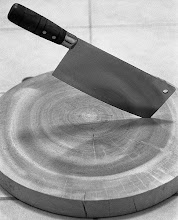Antoine Careme was the first to lay down the basic mother sauces: Veloute, Bechamel, Espagnole, and Allemande. He also included Vinaigrettes.
Escoffier would later update this to include Tomato sauce, and Egg-Based Emulsions (Hollandaise, Mayonnaise). To my knowledge, his version, and the widely-accepted version did not include Vinaigrettes.
It is now roughly a century later. Isn't it about time to update the list? Espagnole is widely unaccepted in most haute-cuisine in favor of one type of reduction or another, be it beef, veal, or even pork. Veloute is still used, although less than in the past, and generally is replaced with a lighter kind of jus, making me wonder if it still deserves to be on the list. Cultural cross-over has brought in many new kinds of sauce which are widely used. Technology has brought us foams and emulsions and encapsulated sauces that were previously un-heard of.
I get asked the question by my younger, more ambitious cooks or apprentices: "What are the five (or sometimes four) basic mother sauces?"
My only response to them generally ends up with me debating with myself exactly what these are these days. I list espagnole, although, as I stated above, it is generally replaced with a reduction now, veloute, simply because it is still in use in some form or another, tomato and egg-based emulsions are still widely used, so I'm fairly solid on them being included. After that, though, things get a little fuzzy. Should I include vinaigrette? What about chemical emulsions and foams? Does the wide use of ethnic sauces earn them a spot? Or do they stay in the ethnic category? Does updating this list even really matter?
To the last question, I say yes. I have a feeling (and it is JUST a feeling, so you can take it or leave it as you like) that there's a lot of confused cooks and chefs out there that may not be being properly equipped by their teachers and chefs for modern cuisine. It is also my feeling that this leads to a lot of the fake-outs and outright lies that you sometimes see on menus created by people who would like to try new things and be ambitious but aren't approaching it in a structured, organized fashion, to the detriment of our craft.
I'd like to think that's what Careme and Escoffier were doing when they listed the mother sauces: saying that this is this and that is that and providing a structure upon which creative minds can work without sacrificing quality or integrity, and making what may have just been a chaos of one-offs and idiosyncracies much more organized and easy to work with.
Or else I'm wrong and this is just another pointless, self-indulgent ramble. Either way. I mean, that's what this is all for, right?
Sunday, August 16, 2009
Subscribe to:
Post Comments (Atom)


No comments:
Post a Comment